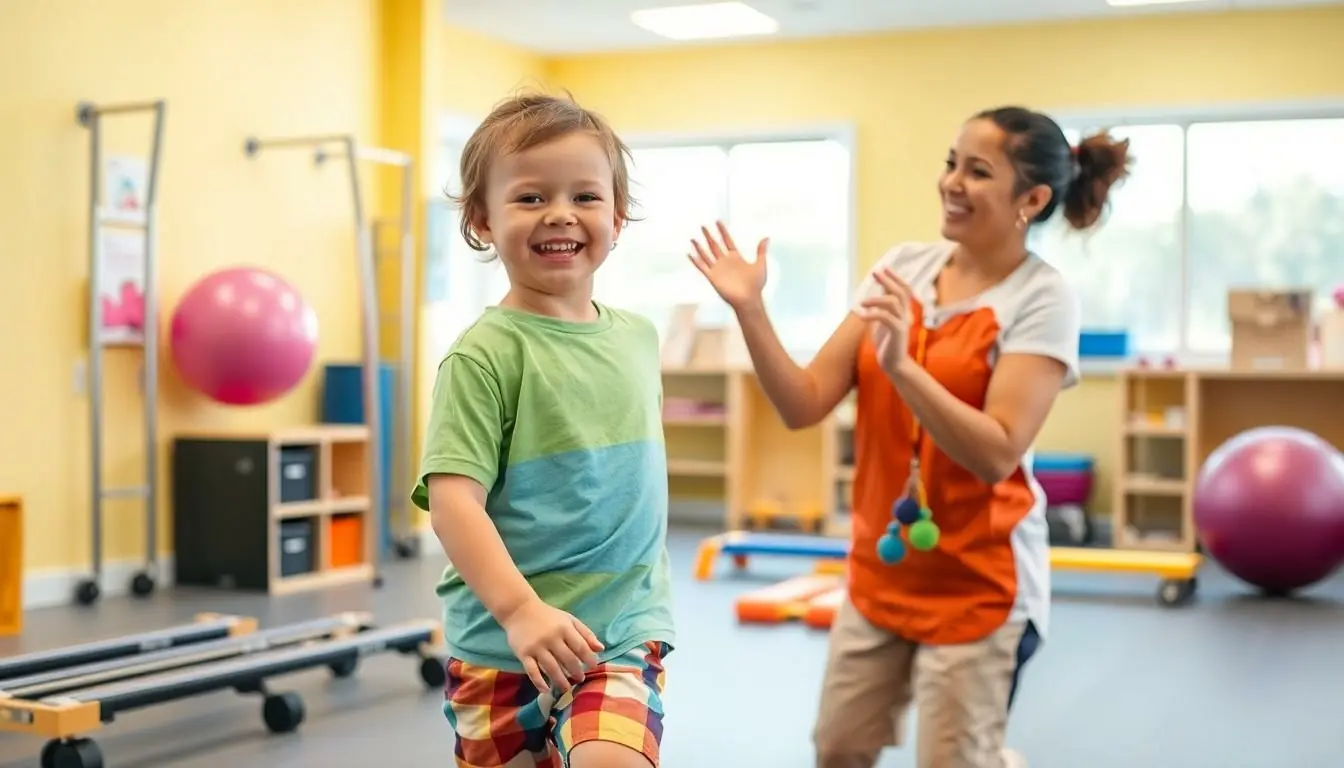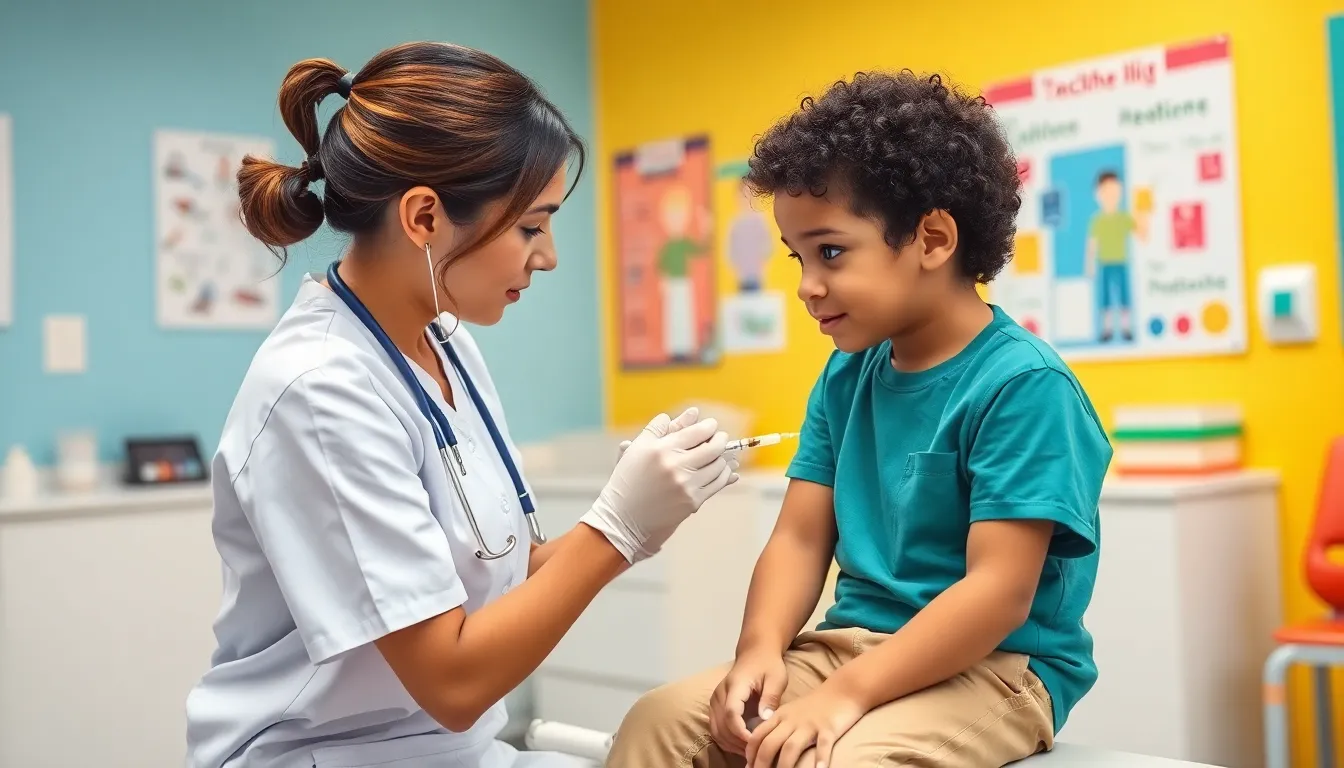When kids tumble, trip, or just decide gravity isn’t their best friend, pediatric physical therapy swoops in like a superhero in scrubs. This specialized field isn’t just about helping little ones bounce back; it’s about turning recovery into a fun adventure. With playful exercises and engaging activities, therapists transform physical challenges into games that kids actually want to play.
Table of Contents
ToggleOverview of Pediatrics Physical Therapy
Pediatric physical therapy focuses on the physical well-being of children from infancy through adolescence. This specialized field plays a crucial role in supporting young patients as they grow and develop.
Definition and Importance
Pediatric physical therapy involves assessing and treating children with various physical challenges. This therapy addresses conditions such as developmental delays, injuries, and congenital disorders. Early intervention can significantly improve outcomes, making it essential for their growth. Therapists tailor treatment plans to each child’s unique needs, utilizing playful methods that keep children engaged. The emphasis on fun helps motivate kids and encourages participation. Parents often see remarkable progress in their child’s physical abilities when therapy is applied consistently.
Key Objectives
Enhancing movement skills forms the primary objective of pediatric physical therapy. Therapists aim to improve coordination, balance, and strength through targeted exercises. Encouraging independence for daily activities also remains a key goal. Another vital objective is improving overall physical health. Pediatric therapists educate families on proper posture and body mechanics, promoting lifelong habits. Supporting social interactions can also be an essential part of therapy. Group sessions can facilitate friendships while practicing motor skills, fostering both physical and emotional development.
Common Conditions Treated
Pediatric physical therapy addresses various conditions that affect children’s mobility and physical development. From developmental delays to orthopedic injuries, therapists provide specialized treatment to support recovery.
Developmental Delays
Developmental delays can hinder a child’s physical, cognitive, or social skills. It affects milestones like crawling or walking, which may lead to difficulties in coordination and balance. Pediatric physical therapists assess each child’s specific needs and design tailored interventions. Techniques often include playful activities and exercises, allowing children to build strength and improve motor skills. Early intervention helps maximize developmental progress, ensuring children catch up with their peers.
Neuromuscular Disorders
Neuromuscular disorders impact muscle control and movement. Conditions such as cerebral palsy or muscular dystrophy result in challenges with strength and coordination. Pediatric physical therapists create individualized treatment plans to enhance mobility and muscle function. Utilizing assistive devices and therapeutic exercises, therapists promote independence and movement efficiency. Engaging activities encourage muscle development in a supportive environment, helping children reach their physical potential.
Orthopedic Injuries
Orthopedic injuries, including fractures or sprains, frequently occur in active children. Treatment focuses on pain relief and restoring function through rehabilitation exercises. Pediatric therapists evaluate the extent of the injury and implement recovery strategies to ensure safe return to activities. Customized therapy regimens enhance strength, flexibility, and overall stability. Incorporating fun and movement-based therapy keeps children engaged while they heal.
Techniques and Approaches
Pediatric physical therapy employs various techniques to support children’s recovery and development. These methods enhance physical skills while engaging children in enjoyable activities.
Therapeutic Exercises
Therapeutic exercises form the foundation of pediatric physical therapy. Exercises like stretching, strengthening, and balance activities target specific muscle groups and improve motor skills. Incorporating playful elements makes these exercises appealing to children, encouraging participation. Therapists design individualized exercise plans based on each child’s needs and progress to provide effective support. For example, obstacle courses engage multiple physical abilities, helping to develop confidence and coordination. Monitoring advancements ensures that therapists adjust exercises for optimal benefit.
Manual Therapy
Manual therapy techniques offer direct hands-on treatment for children. Approaches such as soft tissue mobilization and joint mobilization enhance flexibility and relieve pain. Skilled therapists employ these methods delicately, addressing specific areas of tension or restriction. Techniques are customized to fit the appropriate developmental stage, promoting safe and effective care. For instance, gentle stretching can alleviate discomfort while increasing range of motion. This personalized touch fosters a nurturing environment conducive to recovery.
Use of Technology
The use of technology in pediatric physical therapy enriches treatment options. Tools like interactive games, virtual reality, and mobile applications enhance engagement during therapy sessions. These technologies promote active participation and make exercises enjoyable. Additionally, therapists utilize specialized equipment, such as balance boards or therapeutic toys, to facilitate skill development. Monitoring progress through digital means provides immediate feedback, allowing for real-time adjustments in therapy approaches. Embracing technology supports both motivation and effectiveness in therapy journeys.
Benefits of Pediatrics Physical Therapy
Pediatric physical therapy offers numerous advantages that significantly enhance children’s well-being and development.
Improved Mobility
Improving mobility serves as a primary goal of pediatric physical therapy. Therapeutic exercises enable children to develop essential skills, such as crawling and walking, with increased ease. Mobility challenges often stem from developmental delays or injuries, making targeted interventions crucial. Parents notice their children demonstrating better physical control as they progress through tailored activities. Increased strength and flexibility achieved through these interventions often translate into greater ease in daily movements. Ongoing assessments by therapists ensure that each child’s unique needs are met, enhancing overall mobility.
Enhanced Coordination
Coordination plays an integral role in children’s physical development. Pediatric physical therapy employs engaging activities that focus on fine and gross motor skills. Exercises designed to enhance hand-eye coordination often involve playful elements, capturing children’s interest. Therapists observe marked improvements in children’s ability to participate in sports or group games, supporting their social interactions. Enhancing coordination not only benefits physical activity but also contributes to increased confidence and self-esteem. The combination of structured practice and fun leads to significant advancements in children’s ability to coordinate movements effectively.
Increased Independence
Increasing independence is a crucial benefit of pediatric physical therapy. As children progress through their therapy sessions, they often gain the skills necessary to perform daily tasks independently. Activities tailored to specific challenges encourage self-sufficiency, whether dressing, grooming, or playing with peers. The feeling of autonomy motivates children to engage more actively in their therapy, fostering a positive attitude towards physical activity. Parents witness remarkable transformations as their children develop confidence in their abilities. Overall, pediatric physical therapy nurtures this independence through personalized treatment plans.
Conclusion
Pediatric physical therapy plays a vital role in fostering children’s physical development and recovery. By employing playful methods and tailored interventions, therapists create an engaging environment that encourages participation and progress. This specialized care not only addresses physical challenges but also promotes emotional well-being and social skills.
Through early intervention and personalized treatment plans, children can achieve significant improvements in mobility, coordination, and independence. The integration of technology and innovative techniques further enhances the therapeutic experience, ensuring that each child receives the support they need. Ultimately, pediatric physical therapy is essential for helping children reach their full potential and enjoy a healthier, more active life.




